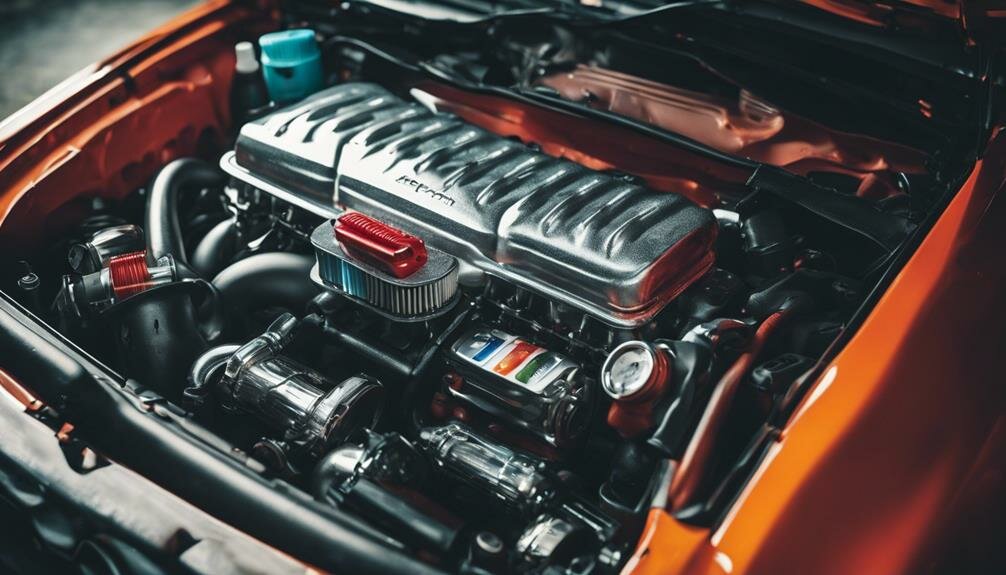To detail a car engine, follow these steps:
Gather Your Supplies:
- Gloves, safety goggles, respirator mask
- Stiff- and soft-bristled brushes
Prepare the Engine:
- Cover battery terminals and air intake with plastic bags
- Wrap exposed filters and electrical connections
- Cover the alternator
Degrease and Clean:
- Apply degreaser, let sit for 10-15 minutes
- Scrub hard-to-reach areas
- Use mild detergent and specialized cleaners
Rinse and Dry:
- Rinse from top to bottom with moderate pressure
- Air dry for 30 minutes, use a leaf blower to remove excess water
Finish and Inspect:
- Inspect belts, hoses, and battery terminals
- Apply protective coating to plastic and rubber parts
Continue to master these steps for an immaculate engine.
Gather Your Supplies

Before diving into engine detailing, make sure you've gathered all the necessary supplies. Having the right equipment will guarantee the job is done efficiently and safely. First and foremost, prioritize your safety gear. You'll need gloves to protect your hands from harsh chemicals and grime. Safety goggles are essential to shield your eyes from any splashes or debris. Additionally, a respirator mask can prevent inhalation of harmful fumes.
Next, focus on your cleaning tools. A variety of brushes will be essential, including both stiff-bristled and soft-bristled types for different parts of the engine. Microfiber cloths are ideal for wiping down surfaces without scratching them. A reliable degreaser is necessary to break down oil and grime. Spray bottles filled with water and a mild detergent can help rinse and clean various engine components.
Checklist:
- Safety Gear:
- Gloves
- Safety goggles
- Respirator mask
- Cleaning Tools:
- Stiff-bristled brushes
- Soft-bristled brushes
- Microfiber cloths
- Degreaser
- Spray bottles (water and mild detergent)
With these items at hand, you're well-prepared to tackle the engine detailing process safely and effectively.
Prepare the Engine
Prepare the Engine
To begin preparing the engine, make sure the car is parked in a well-ventilated area and the engine is cool to the touch. This guarantees safety and prevents potential burns. Once you've confirmed the engine is cool, follow these steps to get the engine ready for detailing.
Cover Components
- Battery Terminals: Use plastic bags to cover the battery terminals. This prevents any cleaning agents from causing electrical issues.
- Air Intake: Cover the air intake with a plastic bag to prevent water and cleaning solutions from getting inside.
- Exposed Filters: Wrap any exposed filters to keep them dry and functional.
Protect Electronics
- Electrical Connections: Identify all visible electrical connections and sensors. Use plastic wrap or small plastic bags to cover them securely.
- Fuses and Relays: Locate the fuse box and ensure it is closed tightly. If it seems loose, cover it with a plastic bag for extra protection.
- Alternator: Cover the alternator to shield it from moisture and cleaning chemicals.
Degrease and Clean

Degrease and Clean
With the engine components safely covered, you can now apply a quality degreaser to break down the grime and grease. Choose a degreaser specifically designed for automotive use to make certain it's safe for all engine parts. Spray the degreaser evenly over the engine, making sure to cover all areas where dirt and grease have accumulated.
Degreasing Tips:
- Let it Sit: Allow the degreaser to sit for about 10-15 minutes. This gives it time to penetrate and break down the stubborn grime.
- Use a Brush: For hard-to-reach areas and tough spots, use a stiff-bristled brush to agitate the degreaser. This helps in loosening the dirt more effectively.
- Work in Sections: Tackle the engine in small sections to guarantee thorough cleaning. Start from one end and systematically move to the other.
Cleaning Solutions:
- Mild Detergent: Mix a mild detergent with water for a safe cleaning solution. This can be used to clean areas that need a gentler touch.
- Specialized Cleaners: For specific materials like aluminum or plastic, use cleaning solutions designed for those surfaces to prevent damage.
Rinse and Dry
Rinse and Dry
Once the degreaser has done its job, you'll need to rinse the engine thoroughly to remove all the loosened grime and residue. Use a hose with moderate water pressure to make certain you don't damage any sensitive engine components. Avoid high-pressure washers as they can force water into electrical connectors and other delicate areas.
Steps to Rinse
- Cover Sensitive Areas: Before rinsing, shield electrical components and air intakes with plastic bags to prevent water from getting in.
- Rinse Methodically: Start at the top of the engine and work your way down. This guarantees that dirt and grime flow downward and away from already-cleaned areas.
- Moderate Water Pressure: Use a garden hose on a gentle setting. High water pressure can cause damage or dislodge parts.
Drying Techniques
Proper drying is essential to prevent moisture-related issues. Here are some effective drying techniques:
- Air Dry: After rinsing, let the engine air dry for about 30 minutes.
- Use a Leaf Blower: Speed up the process by using a leaf blower to remove excess water from nooks and crannies.
- Wipe Down: Use microfiber towels to manually dry surfaces, especially around electrical components.
Finish and Inspect

Finish and Inspect
Once the engine is dry, it's time to inspect your work and apply the finishing touches. Start by examining every part of the engine bay to make sure it's clean. Look for any spots you may have missed and clean them as needed.
Inspect Belts and Check Hoses
- Belts: Examine belts for any signs of wear, cracks, or fraying. These are crucial components, and any damage can impact your car's performance. If you notice any issues, you should consider replacing the belts.
- Hoses: Check hoses for leaks, cracks, or bulges. Hoses are essential for the proper flow of fluids in your engine. Ensure they are firmly attached and free from any visible damage. Replace any hoses that show signs of wear.
Final Touches
- Protective Coating: Apply a protective coating to the plastic and rubber parts. This not only gives a clean look but also preserves the materials.
- Battery: Clean the battery terminals if they appear corroded. Use a battery terminal cleaner or a simple mix of baking soda and water.
- Fluid Levels: Finally, check all fluid levels, including oil, coolant, and brake fluid. Top off any fluids that are low.





